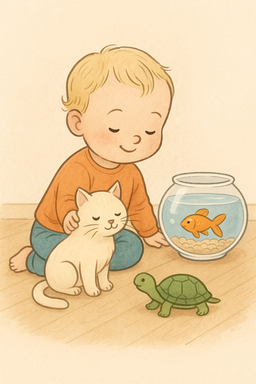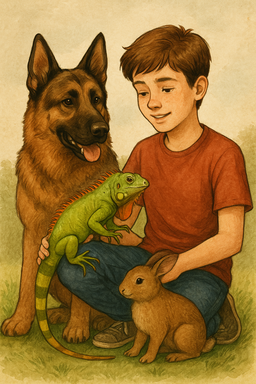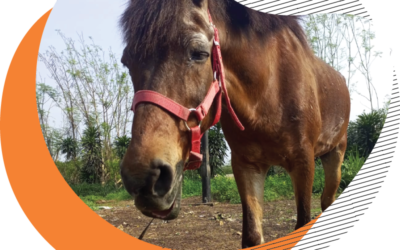
Pets Suitable for Children, According to Age!
Find the right pet for your child based on their age. From fish to dogs, check out our child-friendly pet recommendations here!
By: Drh. Mikeu Paujiah, Dipl. Montessori
Choosing a pet for your child isn’t just about picking the cutest one. Every animal has its own personality and specific care needs. Likewise, every child has a different level of maturity and ability to care for pets, depending on their age and emotional readiness.
So, if you want to introduce your child to a pet, first get to know the types of animals most suitable for each age group. That way, the experience of having a pet can be joyful—not a burden.

Toddler Age (1–4 years): Focus on Safe Interaction
At this age, children are still learning to control their emotions and motor skills. They tend to be impulsive and haven’t yet learned boundaries.
Recommended pets:
-
Fish (such as guppies or bettas)
-
Small turtles
-
Rabbits (with close supervision)
Note:
Pets at this stage are more for observation than for frequent touching. Parents play a 100% dominant role.

Preschool – Early Elementary (5–7 years): A Great Time to Learn Responsibility
Children at this age can begin to take on small tasks like feeding or cleaning food containers.
Recommended pets:
- Rabbits
- Hamsters
- Tame Cats
- Gold Fish
Tips :
Choose pets that are non-aggressive and easy to care for. Involve the child lightly in the daily pet care routine.

Elementary – Pre-Teen (8–11 years): Becoming Independent and More Empathetic
Children in this age group are usually more patient and better understand animal needs.
Recommended pets:
- Small dog breeds (like Pomeranians or Beagles)
- Cats
- Budgies or lovebirds
Note:
They can start learning to schedule feeding or clean cages with light supervision.

Teenagers (12 years and older): Ready for Bigger Responsibilities
Children at this age are generally able to care for pets more independently, even taking full responsibility.
Recommended pets:
- Medium to large dog breeds
- Any breed of cat
- Reptiles (with proper education and understanding)
- Adopted animals from shelters
Suggestion:
Encourage your teen to be involved in the adoption decision, from researching to understanding care costs.
Important Notes Before Choosing a Pet for Your Child
Before adopting a pet, consider the following:
- The animal’s lifespan (don’t choose just because it’s cute)
- Your family’s time and financial capacity
- Are there any allergies at home?
- Is every family member ready?
Don’t Choose Randomly. Choose the One That Clicks with Your Heart and Fits Your Home!
Choosing the right pet for your child is not just about age—it’s about family readiness too. The right pet can become a learning companion, a furry friend, and a responsibility trainer.
Once you know what pet fits best, don’t forget to teach your child how to treat animals kindly. And remember, animals have the right to be loved and cared for their entire lives.
Reference
Editorial, P. (2019, March 18). These are the best pets for kids at each age. PetMD. https://www.petmd.com/dog/pet-lover/these-are-best-pets-kids-each-age?
(N.d.). WebMD. Retrieved April 9, 2025, from https://www.webmd.com/pets/best-pets-for-kids
Related Post
Things you need to know about your cat’s natural behavior
Cat’s natural behavior is related to age, personality and past experience. Cats really love to play, both with their humans or toys. Playing and moving around is really important for their physical and mental health. Although they sleep most of the day, they still need to move around and play.
TREATMENT OF PRIMATES FOR COMMERCIAL PURPOSES SEEN FROM ANIMAL WELFARE POINT OF VIEW
TREATMENT OF PRIMATESFOR COMMERCIALPURPOSES SEEN FROMANIMAL WELFAREPOINT OF VIEW By: Atian Muhammad Zaky Fahrian Translator : Ludmila The first thing I’d like to address is that there are many content creators who keep wild animals and show them on their social media...
Pets as property in Animal Welfare
Pets as propertyin Animal WelfareCitayam Fashion Week in Jakarta is now booming and attracts people’s attention, especially those with a passion for the modeling world. This weekly event shows street fashion a la Harajuku in Japan which attracts people both locally...
Feline Behavior Guidelines
The benefits of living with a pet are now well
recognized. By preventing and treating
behavioral problems, we have the opportunity to
protect and strengthen the
human-pet-veterinary bond and increase the
quality of life for both pets and pet lovers. The
goals of the American Association of Feline
Practitioners (AAFP) Feline Behavior
Guidelines are to support veterinarians and Cat
Lovers by providing practical information and
client educational materials to
successfully incorporate feline behavioral
medicine into every practice that offers feline
healthcare
A Few Tips to Minimize The Stress to The Pets During The New Year Eve
A Few Tips to Minimize The Stress to The Pets During The New Year Eve. Pets which not familiar with loud sound will have fear then have stress and frustration.Stress will decrease immunity,and if this happens in the long term, eventually will affect pets behavior and health. Facts The sound of Fireworks,firecrackers or other loud sound will make the pets having a tremendous
fear, frighten and frustration during the event.The animals usually want to go as far as they can get
when they hear the sound of fireworks,firecrackers and other loud sound,because they have very
sensitive hearing.
Horse Care Guideline
Your horse depends on your love, care and
commitment, which you can show through
grooming, petting, riding and the occasional
treat. With good care, your horse can live 35
years or more.





